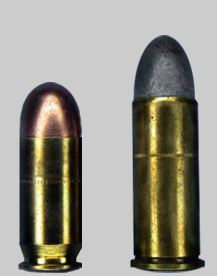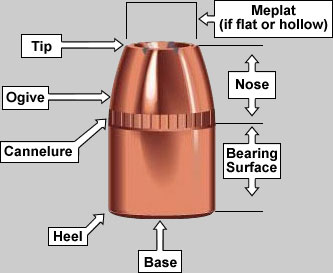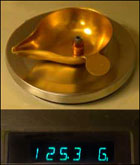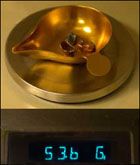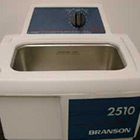Home | Glossary | Resources | Help | Contact Us | Course Map
Archival Notice
This is an archive page that is no longer being updated. It may contain outdated information and links may no longer function as originally intended.
Physical Features
Most modern bullets fall into two categories:
- Plain lead bullets ( swaged or cast)
- Jacketed bullets (heavy core enclosed by an outer jacket of gilding meta(heavy core enclosed by an outer jacket of gliding metal)
Within these two categories, there are a wide variety of bullet designs intended to improve performance for a particular purpose.
Terminology
| Common Terms | |
|
Term |
Definition |
| Bullet | Nonspherical projectile for use in a rifled gun barrel |
| Tip | Extreme forward end of a bullet |
| Meplat | Blunt tip of some bullets, specifically the diameter of that blunt tip |
| Ogive | Curved forward part of a bullet |
| Nose | Forward end of a bullet, including the tip, the ogive, and meplat (if present) |
| Cannelure | Circumferential groove in a bullet generally of a knurled or plain appearance for the purpose of lubrication or identification, or to assist in crimping a bullet in the mouth of a cartridge case |
| Bearing surface | Portion of the outer surface of a bullet that makes direct contact with the interior surface of a gun barrel |
| Base | Rear portion of a bullet |
| Heel | Configuration of the intersection of the bearing surface and base of a bullet |
Characteristics
The categories of physical features of bullets are extensive and can be used to search reference materials for bullets with similar features.
The primary physical features of bullets include these:
- Weight
- Measured caliber/diameter
- Composition
- Jacket type
- Magnetic properties
- Length
- Color/finish
- Base construction
- Base shape
- Nose construction
- Nose shape
- Cannelures
Weight
The weight of a bullet is normally measured in grains using a balance. There are 7000 grains per pound or 437.5 grains per ounce.
The weight of a relatively intact bullet is a partial indicator of the type(s) of cartridge that may have contained the bullet. Weight is one of the factors used to determine cartridge type(s).
In the following chart, the weight of a bullet in grains corresponds to possible cartridge type(s). A bullet weight may overlap several cartridge types, indicating that more data are needed to narrow the field.
| Range of Bullet Weights for Various Cartridge Types |
|
| CARTRIDGE | WEIGHT RANGE (grains) |
| 17 Remington | 25 |
| 22 Short | 27-30 |
| 22 Long Rifle | 36-40 |
| 22 Win Mag | 30-50 |
| 25 ACP | 45-50 |
| 7.62 Tokarev | 84-92 |
| 7.65 (30 Luger) | 90-96 |
| 32 S&W | 85-88 |
| 32-20 WCF | 90-115 |
| 32 Short Colt | 80 |
| 32 Long Colt | 82 |
| 32 S&W & 32 S&W Long | 95-100 |
| 32 Auto | 60-71 |
| 8mm Nambu | 99-103 |
| 380 Auto | 85-102 |
| 9mm Parabellum | 88-147 |
| 9mm Makarov | 90 |
| 9mm Steyr | 114-118 |
| 9mm Mauser | 123-128 |
| 38 S&W | 145-150 |
| 38 Long Colt/Colt New Police | 148-150 |
| 38 Special | 95-158 |
| 357 Magnum | 110-180 |
| 38 Auto | 115-147 |
| 40 S&W | 141-180 |
| 10mm Auto | 155-200 |
| 41 Rem Magnum | 170-240 |
| 41 Short Colt | 160-167 |
| 44 Rem Magnum | 180-275 |
| 44 S&W Spl | 200-246 |
| 45 ACP | 175-230 |
| 45 Colt | 225-255 |
| Popular small caliber excluding reloads Sources: Hatcher, H.P.White Lab, CCI, Winchester, Remington, Federal |
|
Considerations
When obtaining the remaining weight of a fired evidence bullet, the examiner should bear in mind the following considerations:
- Laboratory safety protocols should be followed.
- Laboratory trace evidence policies should be followed prior to and during removal of any material adhering to a bullet.
- Bullets should be cleaned so as to not damage the surfaces potentially bearing microscopic marks.
- Soak in a mild detergent to loosen any adhering material. Gently scrub using a soft bristled toothbrush.
-and/or-- Use an ultrasonic cleaner and appropriate fluid.
- Follow the manufacturers recommendations.
- Treat one bullet/fragment at a time.
- Monitor and observe bullets during treatment; ultrasonic cleaning may alter the microscopic details on the surface of a bullet.
- Use appropriate tools to mechanically remove debris (e.g., embedded wood particles, bone, cartilage).
- Use an ultrasonic cleaner and appropriate fluid.
- Soak in a mild detergent to loosen any adhering material. Gently scrub using a soft bristled toothbrush.
- Weigh each bullet fragment separately because they may or may not originate from a single bullet. Individually weighed fragments can be regrouped later, if necessary.
Additional Online Courses
- What Every First Responding Officer Should Know About DNA Evidence
- Collecting DNA Evidence at Property Crime Scenes
- DNA – A Prosecutor’s Practice Notebook
- Crime Scene and DNA Basics
- Laboratory Safety Programs
- DNA Amplification
- Population Genetics and Statistics
- Non-STR DNA Markers: SNPs, Y-STRs, LCN and mtDNA
- Firearms Examiner Training
- Forensic DNA Education for Law Enforcement Decisionmakers
- What Every Investigator and Evidence Technician Should Know About DNA Evidence
- Principles of Forensic DNA for Officers of the Court
- Law 101: Legal Guide for the Forensic Expert
- Laboratory Orientation and Testing of Body Fluids and Tissues
- DNA Extraction and Quantitation
- STR Data Analysis and Interpretation
- Communication Skills, Report Writing, and Courtroom Testimony
- Español for Law Enforcement
- Amplified DNA Product Separation for Forensic Analysts


